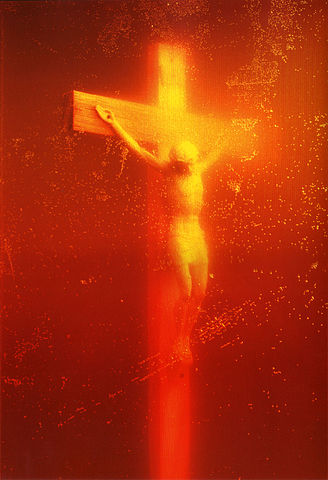
Written by Lawrence Garcia
The Edward Tyler Nahem Gallery in Manhattan recently managed to transform itself into a neo-Golgotha with the public display of a denigrated Christ submerged in human urine. This is Andres Serrano’s infamous Piss Christ, a photograph taken in 1987 of a crucifix baptized in the artist’s own widdle. Of course, the disclosure is on the heels of heightened global tension between Christians and Muslims giving rise to an outcry of protest across the nation. Moreover, the public airing of the photograph sharpened a host of sociopolitical differences surrounding free speech, hate crime, and religious freedom between Liberals and Conservatives and those in between. Of particular interest for this author was the Christian reaction; a quick survey of the backlash will yield statements like:
—“ANYONE who would WANT to desecrate our LORD in this Manner is a sick soul…”
—“AND, how about “Piss Mohammed?”
—“Let’s riot and burn somebody’s embassy…”
—“Now, more than ever, Christianity is under attack from without and within. We need your help to stand for Christ…”
It is, of course, perfectly natural if one is a follower of the Christ to feel a deep disgust, a churning of the stomach over such wanton sacrilege. And before we know it, we are being driven headlong on a crusade to ‘defend,’ ‘protect,’ and ‘avenge,’ the Lord’s public honor. John Calvin’s famous words seem particularly applicable, “A dog barks when his master is attacked. I would be a coward if I saw that God’s truth is attacked and yet would remain silent.” And yet, the emotive desire to shield Jesus from any and all disgrace, though admirable, may stem from a deep seated theological misunderstanding about the nature of the crucifixion itself.
Have we forgotten that crucifixion in the ancient world was the servitutis extremum summumque supplicium—“the supreme and ultimate punishment for slaves”—according to Cicero?[1] And no, crucifixion did not occur in a dark corner, it was carried out in crowded-public areas as empire’s deterrent against would-be rebels. Emaciated bodies, broken bones, torn flesh, exposed organs, public defecation, impaled private parts, bodies creatively strewed this way and that according to the executioner’s fancy were all features of the spectacle which is crucifixion; and such is what Jesus of Nazareth considered his hour of “glory.” “What should I say,” Jesus says about his impending crucifixion, “‘Father, rescue me from this hour?’ No, for it was this reason I came to this hour!”
How can we ever, in a thousand lifetimes, hope to disgrace such a person?—one who so claims that all that is shameful and ghastly and nauseating in the world are now and forever taken up into his own passion! We could even say—dare we say?—that David’s Rightful Heir willingly chose to be the “Piss Christ”—the loving king who for three agonizing and humiliating hours became the world’s commode. This is what Paul meant by the “scandal” of the cross, that a basin-throned Jew was now Lord of the world and that one day the refuse of society would inherit the earth along with him. Who would ever believe that?! Therefore, we need not get angry, vindictive, or even necessarily disgusted with the photograph, but rather stand in silent awe and wonder that it manages, in all of its profaneness, to capture a momentary glimpse of our Lord’s paradoxical “hour of glory.” I’ll end with words from William Willimon:
“Everything about Jesus is cruciform, shaped like a cross. The cross was not just an unfortunate event on a Friday afternoon at the garbage dump outside Jerusalem; it was the way the world welcomed the lover Jesus from day one and still does today… From his very first sermon at Nazareth, the world was attempting to summon up the courage to render its final verdict upon Jesus’ loving reach, ‘Crucify him!’”[2]
Glory be to the King who was willingly and figuratively pissed on for you and for me.
[1] Hengel Martin, Crucifixion: In the Ancient World And the Folly Of the Message Of the Cross (Philadelphia: Fortress Press, 1977), 51.
[2] Willimon William, Why Jesus? (Nashville: Abingdon Press, 2010), 109.
—————————————————————–
Lawrence is the Senior Teaching-Pastor of Academia Church in Goodyear, Arizona. He is a pastor devoted to the educational growth of his congregants, and the raising up of a new generation of disciples, who will think, tell, and live out the Christian story. Lawrence is currently attending Liberty University.












